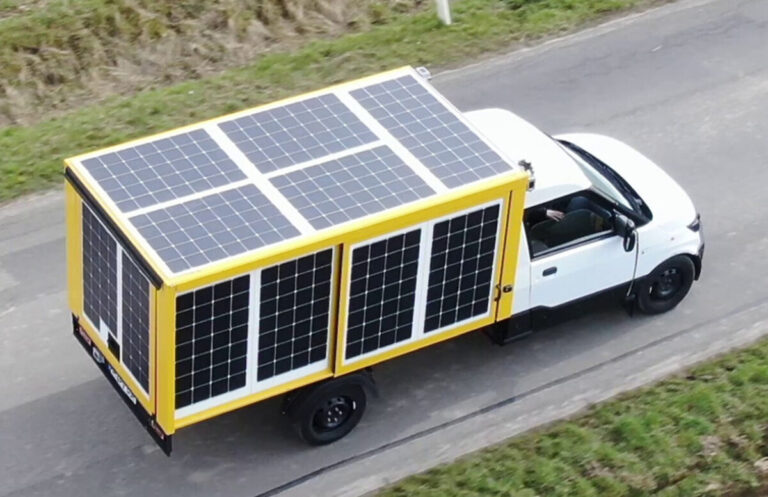A European research team has installed solar panels on a slightly commercial electric vehicle and has tested their performance for four months. The vehicle was able to extend the range by 530 km, although not all panels have contributed immediately. System efficiency was measured up to 66%.
Researchers from Germany and the Netherlands have mounted PV modules on a slightly commercial electric vehicle (EV) and have been measured for four months.
During this time, the EV made 45 minutes of travel from the house of a researcher in the German Hanover to the Institute for Solar Energy Research Hamelin (ISFH), stayed there for a few hours and then returned to the afternoon for the Rest of the day before he was brought in for charging the schedule.
“This work is a continuation of one beyond paper in which an energy flow analysis of the collected data was presented for a single exemplary day. Here we present a more detailed and statistically healthy analysis for a long period of 4 months from April to July 2021, “the scientists said. “The focus will be on individual components in the system, such as PV modules, MPPTs, low-voltage (LV) buffer battery, DC-DC converter, high-voltage (HV) vehicle traction battery and the total losses that occur in the system. “
The EV itself is based on the Streetscooter model L. The peak power of the M2 Wafer Silicon PV modules was 2,180 W, with 875 W on the roof, 215 W on the back and 545 W on the left and right side. The roof modules were individually connected to 5 separate MPPTs, while in the rest of the EV every two modules in series were connected to a single MPPT tracker. All MPPTs were connected to the LV battery and the DC-DC converter, which supplied the power to the HV battery of the vehicle.
“The front of the vehicle looks at the northwest at both locations, but at ISFH it is parking in the morning when the sun rises, and the sun goes down at home,” the academics said. “The back has a similar radiation profile in both parking locations, because the vehicle orientation is almost identical. During the Rijfas, because the vehicle orientation varies continuously compared to the sun, and because of the obstruction of surrounding objects, the rear, left and right-hand side receive relatively less irradiation. “
Photo: Institute of Energy, Materials and Devices – Photovoltaics (IMD -3), Progress in Photovoltaics, CC by 4.0
Based on their measurements, the parking time was approximately 106.7 and 382.22 hours for the ISFH and Home Parking respectively. A combined total of 49.06 kWh for ISFH parking and 153.32 kWh for home parking was available after the MPPT conversion phase. 29.16 kWh (ISFH) and 98.57 kWh (home) loaded the LV battery, 19.9 kWh (ISFH) and 54.75 kWh (at home), transferred directly to the DC-DC converter and 5, 96 kWh (ISFH) and 12.92 kWh) and 12.92 kWh) and 12.92 kWh) and 12.92 kWh) (at home) were the system consumption loss of the system.
“The LV side of the DC-DC converter receives 38.73 kWh (ISFH) and 129.18 kWh (at home), which is sent to the HV battery. After considering the losses in the HV battery, the usable energy for traction is 29.65 kWh (ISFH) and 99.74 kWh (at home), ”they added. “The PV module 9.8 kWh produced electricity with a conversion -efficiency of 18.01%in the Rijfas. After the MPPT conversion phase, 8.3 kWh electricity is available for the further phases, of which 4.3 kWh charges the LV battery and 4 kWh and will be provided directly to the DC DC converter. The final output of the DC-DC converter is 5.5 kWh, which is transferred to the HV battery of the vehicle during the RIJ battery. “
The overall system efficiency, taking into account multiple power conversion phases, loading batteries/discharging losses and losses, turned out to be 60.44% for ISFH parking, 65.05% for home parking and 66.26% for travel. Based on the average consumption per kilometer of all trips and the total PV energy injected into the battery, the team estimated that the PV electricity has contributed 530 km to the reach of the EV during the measured period, which 30% of The total distance is of the total distance of 1750 km.
Their findings were presented in “Performance analysis of a built -in PV system on a demonstrator of light commercial vehicle in Hanover, Germany“Published in Progress in photovoltaic. Scientists from the German Institute for Energy, Materials and Fotovoltaic means (IMD-3), Institute for Solar Energy Research Hamelin (ISFH) and Dutch Eindhoven University of Technology have conducted the study.
This content is protected by copyright and may not be reused. If you want to work with us and reuse part of our content, please contact: editors@pv-magazine.com.
Popular content



